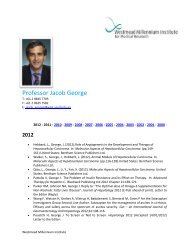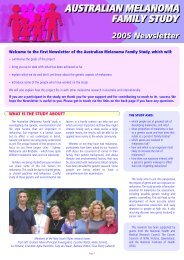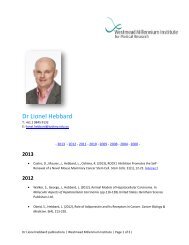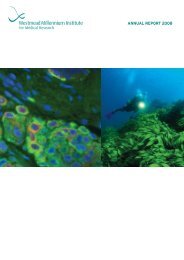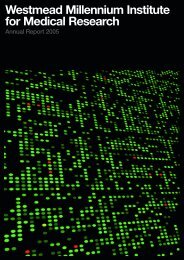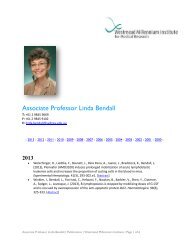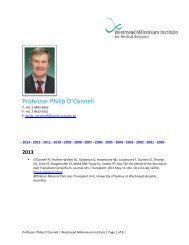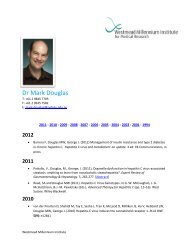Translating >> - Westmead Millennium Institute
Translating >> - Westmead Millennium Institute
Translating >> - Westmead Millennium Institute
- No tags were found...
Create successful ePaper yourself
Turn your PDF publications into a flip-book with our unique Google optimized e-Paper software.
46 47 > Research Report // AR 2006<br />
is highly effective in reducing PTSD symptoms. Importantly,<br />
both cognitive therapy and exposure-based therapies are<br />
highly successful in reducing PTSD symptoms compared to a<br />
wait-list control, but PE has greater treatment gains than CR.<br />
Markers of PTSD<br />
The research team is continuing to explore the relationships<br />
between autonomic arousal and neural function in response<br />
to emotional signals and in the context of cognitive tasks.<br />
They have pioneered new integrative analysis techniques<br />
for SCR-fMRI data. They are also examining responses to<br />
positive facial signals in PTSD to explore the integrity of<br />
the reward/approach systems in PTSD. We are examining<br />
structural MRI data to identify specific impairments in brain<br />
regions (particularly anterior cingulate and hippocampus) in<br />
PTSD. Finally, we are integrating autonomic, genetic, spatial<br />
and temporal neural measures (fMRI and EEG) to examine<br />
integrative theoretical models of PTSD.<br />
Depression - objective markers for depression<br />
In Australia, it has been estimated that depression costs<br />
our economy $3.3billion in lost productivity each year,<br />
highlighting the urgent need for valid markers of the illness<br />
and successful treatment. This research, funded by NHMRC<br />
and ARC, is focused on using measures of emotion,<br />
cognition and brain function to identify objective markers<br />
of depression and response to anti-depressant treatment.<br />
Results to date identify distinct brain changes that predict<br />
development of depression.<br />
Pfizer fellowship and NISAD: “Missing links: connectivity<br />
and schizophrenia”<br />
The Centre has focused on young people who have recently<br />
experienced their first-episode of psychosis. The ultimate aim<br />
is to identify the causes of the disorder, and how it might be<br />
prevented or better treated in the future. The project<br />
of normal connectivity revealed in the project reported<br />
under the Cognitive Neuroscience Unit. Schizophrenia<br />
patients showed a reversal of the normal connectivity<br />
between amygdala-frontal networks for processing<br />
stimulus significance.<br />
The inability to ‘bind’ perceptions and cognitions into<br />
a coherent whole in schizophrenia may involve the<br />
networks for determining significance. The findings<br />
support the Centre’s model of schizophrenia as a disorder<br />
of neural connectivity.<br />
Structural brain alterations in schizophrenia<br />
This is a PhD research project which used high-resolution<br />
(~1mm3) images of the brain provided by structural MRI<br />
(sMRI). The same first episode group was studied to provide<br />
a means to link information across projects.<br />
First episode schizophrenia patients showed a loss of grey<br />
matter in the frontal, parietal and temporal cortices, as well<br />
as cerebellum, at the time of their first presentation to mental<br />
health services, relative to matched healthy controls.<br />
In addition, these reductions in grey matter followed a<br />
different pattern of relationship to neural activity to that in<br />
healthy controls. In healthy subjects, grey matter declined<br />
slightly (consistent with neural pruning) and EEG activity<br />
(indexing neural activity) followed a similar pattern. In<br />
schizophrenia, however, there was a preservation or even<br />
increase of EEG activity, particularly for the slow wave Theta<br />
band. This dissociation in schizophrenia is consistent with a<br />
disorganization of pruning, and may be a factor in the cause of<br />
schizophrenia in late adolescence. The increase in EEG activity<br />
may reflect increases in synchronized activity in particular.<br />
Centre for Vision Research<br />
The Blue Mountains eye study<br />
The Blue Mountains Eye Study is a benchmark populationbased<br />
study in ophthalmology. As well as defining the<br />
prevalence, incidence and risk factors for eye diseases, many<br />
novel systemic associations have been explored. The 10-<br />
year mortality and cause of death information from this<br />
Blue Mountains population has been explored in relation<br />
to information derived from grading photographs taken of<br />
the retina at the back of the eye. Retinal vessels may carry<br />
information about the circulation system in the brain and<br />
in other end organs of the body. Our data have shown<br />
that retinal photographs provide information on structural<br />
changes in small vessels of the retina. These signs may<br />
be independent sub clinical markers for vascular disease,<br />
predicting subjects at higher risk of future vascular events,<br />
including the development of stroke, stroke-related death,<br />
cardio-vascular death and high blood pressure in older<br />
people. The Centre has also led to data analyses pooling Blue<br />
Mountains Eye Study and Beaver Dam Eye Study (USA)<br />
data to investigate less frequent retinal vascular lesions such as<br />
retinal emboli and retinal vein occlusion.<br />
Retinal vessel signs in acute stroke patients<br />
This multi-centre clinical cohort study has recruited acute<br />
stroke patients from three centres (stroke units at <strong>Westmead</strong><br />
Hospital, Royal Melbourne Hospital and Singapore General<br />
Hospital) to assess whether retinal vessel signs can help to<br />
determine the prognosis for different clinical stroke subtypes,<br />
in collaboration with the Retinal Vascular Imaging Centre<br />
(RetVIC) in Melbourne and stroke specialists in Singapore.<br />
So far, more than 1300 patients have been recruited<br />
following acute stroke. Retinal photographs were taken and<br />
the assessment of these signs is currently underway.<br />
Cataract surgery and risk of age-related macular Degeneration<br />
Age-related Macular Degeneration (AMD) is the leading<br />
cause of blindness in older people. Previous populationbased<br />
studies have suggested at least a 3-fold higher risk of<br />
progression to late-stage AMD in eyes after cataract surgery.<br />
This project aims to confirm these findings in a much larger<br />
sample of older people having cataract surgery and also to<br />
look at cataract surgery outcomes, including the impact on<br />
quality of life.<br />
Almost 2,000 patients undergoing cataract surgery at<br />
<strong>Westmead</strong> Hospital and from private ophthalmologist rooms<br />
have been recruited, with over 1200 patients being reexamined<br />
6 months post-operatively. We plan to follow these<br />
patients for up to 5 years to assess both short-term (2-3 years)<br />
and long-term risks of AMD after cataract surgery.<br />
The Sydney childhood eye study<br />
This project has assessed the frequency and risk factors<br />
associated with myopia and other common eye conditions<br />
in school children aged 6 or 12 years. The project examined<br />
1740 6-year-old and 2353 12-year-old children from almost<br />
60 primary and secondary schools across Sydney.<br />
Reports from this study have identified that reduced outdoor<br />
activity, rather than increased close work, may predict<br />
myopia (short-sightedness). The study also showed that other<br />
common childhood eye conditions like amblyopia (reduced<br />
vision in one eye) and strabismus (squint) are relatively well<br />
detected at present, but identified new risk factors, particularly<br />
modest levels of lower birth weight or prematurity.<br />
The new phase (Sydney Paediatric Eye Disease Study) is now<br />
examining a large sample of children aged less than 6 years<br />
to determine factors associated with the development of<br />
amblyopia and its detection in very young children.<br />
compared first episode schizophrenia patients to the pattern



